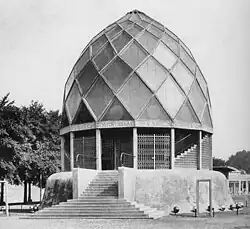
The first Werkbund Exhibition of 1914 was held at Rheinpark in Cologne, Germany.
History
The German Work Federation, or the Deutscher Werkbund, was founded with the intention to blend art with industry. The federation was founded in 1907 by twelve architects and twelve entrepreneurs including Ludwig Mies van Der Rohe and Walter Gropius.[1]
The Werkbund exhibition of 1914 in Cologne was the first exhibition of the Deutscher Werkbund. It opened to the public on May 15, 1914. The exhibition lasted only three months and was prematurely shut down due to the outbreak of World War I.[1]
Facilities
Glashaus
The innovative glass pavilion was built by German architect Bruno Taut in 1914. Glashaus has been identified as an early example of the Expressionist architecture movement.[2]
Werkbund Pavilion
The Werkbund Pavilion was a model factory and office building designed by Walter Gropius and Adolf Meyer.[3]
Farbenschau Pavillon
The Farbenschau Pavilion by Hermann Muthesius was a neoclassical style. The building features a large dome and paired columns along the front facade. This pavilion showcased exhibits for chemical dyes.[4]
Festive Hall
The Festive hall by Peter Behrens was also a of neoclassical style with resemblance to Palladio's designs.[4]
Werkbund Theater
The Werkbund Theater is the work of Belgian architect Henri van de Velde. The theater building could be described as a trailblazer for a style we now understand is the International Style. The Werkbund Theater is featured in Walter Gropius's Bauhaus book International Architecture (1925).[4]

Art Contributions
The theater housed many contributions from German artists, including the fountain in front of theater, sculpted by Georg Kolbe. The sculpture in the middle of the fountain was a human form standing on one leg in a bath of water, centered in the front of the entrance to the building.[4]
In a different style, Hermann Obrist had multiple sculptures around the theater including two relief sculptures resembling the shape of an eye. Obrist also had two freestanding sculptures, one was a fountain unconnected to a water source. His contributions to the theater had a theme of nature, but instead of being smooth and sleek like the buildings facade or Kolbe's sculpture, Obrist's designs included many sharp points. Van de Velde seemed to debate the addition of Oboist's contributions due to their overwhelming contrast, and the pieces were added just in time for the exhibition.[4]
Some of the other art contributions occurred inside the theater, including Milly Steger's sculptural relief, Ludwig von Hofmann's painted murals, along with Lisa Brentano's painted tiles.[4]
See also
References
- 1 2 "Deutscher Werkbund | German Art & Design Movement | Britannica". www.britannica.com. Retrieved 2023-12-02.
- ↑ Gutschow, K. K. (2006). "From Object to Installation in Bruno Taut's Exhibition Pavilions". Journal of Architectural Education. 59 (4): 63–70 – via JSTOR.
- ↑ Nyberg, Folke (1992). "From Baukunst to Bauhaus". Journal of Architectural Education. 45 (3): 130–137 – via JSTOR.
- 1 2 3 4 5 6 Kuenzli, Katherine M. (2012). "Architecture, Individualism, and Nation: Henry van de Velde's 1914 Werkbund Theater Building". The Art Bulletin. 94 (2): 251–273. ISSN 0004-3079.